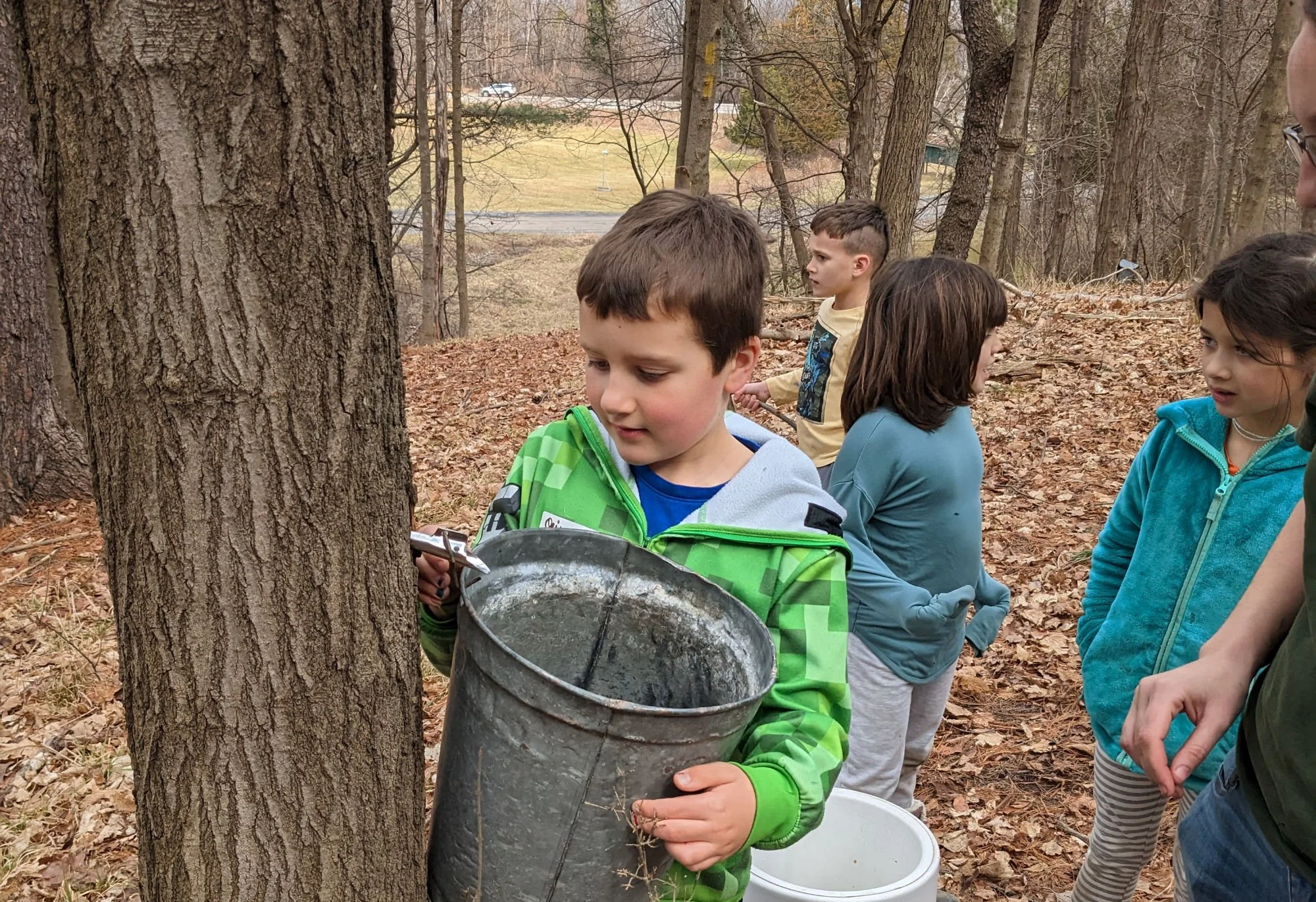Warm, Weird, Wonderful, Worrisome—What to Make of a Warm Spell in February
Children tapping sugar maple trees at the Cayuga Nature Center in Ithaca, NY. Photo by Katie Bagnall-Newman
by Katie Bagnall-Newman, Director of Nature Center Programs, and Dr. Ingrid Zabel, Climate Change Education Manager
March 16, 2023
Here at the Cayuga Nature Center, we’ve been tapping sugar maple trees for many years. Staff remember historically tapping trees for our School’s Out program in mid-February for visitors to enjoy, however we didn’t usually see a strong sap flow until late February or early March. This year, we watched the weather closely, and tapped when sap was flowing strongly—in early February!
Maple sap bucket at the Cayuga Nature Center. Photo by Katie Bagnall-Newman
Is climate change behind this? Sugar maple sap starts to flow under specific temperature conditions—when nightime temperatures are below freezing and daytime temperatures are above 40°F—so having warm weather earlier in the winter makes a difference. Weather fluctuates from year to year, and one warm winter is not evidence of climate change. But the historical record shows that Central New York has been heating up over many decades. From 1896 to 2022, the average winter temperature in Tompkins County rose at a rate of 0.2 °F per decade (see Figure 1). The pace of the Earth’s temperature rise accelerated in the 1970s, and since 1970 Tompkins County’s average winter temperature has risen at a rate of 0.7°F per decade. That’s a 3.5°F total increase over about 50 years. No other season has warmed so much in our region.
Figure 1: Tompkins County, NY winter average temperatures from 1896-2022. Data from the National Oceanic and Atmospheric Administration (NOAA), Climate at a Glance County time series
We are not the only ones to see an early sap flow. Many producers across the Northeast are seeing earlier and shorter tapping seasons. Some producers are adjusting to these changes by utilizing new technology to improve efficiency and by tapping when the weather is best as opposed to following a calendar.
Is February warmth wonderful or worrisome?
Warm winter weather can feel wonderful! An unusually warm day can feel like a hint of the spring to come, and a welcome respite from the cold—even for those of us who like winter. But exceptionally warm winter weather can be worrisome, too.
The year 2012 provides a cautionary tale. January and February of 2012 were much warmer than average here in Ithaca, NY, and March 2012 brought a week with high temperatures in the 70s (°F); see Figure 2. This included three days with record high temperatures of 77°F. Many trees responded to the warm weather and started to bloom early, both in Ithaca and around New York State. Then we were hit by several hard frosts, with two nights in early April dipping to record low temperatures. These frosts damaged the blossoms on many trees, including important fruit crops. The result for New York State was loss of almost 50% of apple crops, 90% of peach crops, and high losses to cherry and grape crops.[1]
Figure 2: 2012 data from Cornell University’s weather station at Game Farm Rd., Ithaca, NY. Source: Northeast Regional Climate Center
Will 2023 be another year like 2012? Right now in early March we don’t know yet if we’ll get a hard, late-season frost that could cause damage. We make close observations of several trees at the Cayuga Nature Center for the U.S.A. National Phenology Network, and so far these trees have not started blooming or leafing out early, despite the warm February weather. As Central New York’s climate continues to change, farmers and growers will need to adapt to become more resilient, and develop techniques to protect the crops we all love. Cornell University’s Climate Smart Farming program has developed tools to help growers adapt to changing winter and spring conditions, such as a Grape Hardiness and Freeze Risk tool, and an Apple Stage / Freeze Damage Probability tool.
This year at the Cayuga Nature Center we’ve seen maple sap flowing strongest in early February, but are still seeing minimal sap flow at the end of the month. Fortunately we had a good yield this year, in part due to our quick tapping when weather conditions were best. We’re looking forward to our boil this year and for years to come!
Learn More
Information about climate change and sugar maples on Earth@Home: Sugar Maples and Climate Change
Learn more about climate change on the Digital Encyclopedia of Earth Science and on Earth@Home’s answers to Frequently Asked Questions
References
[1] P. Ritchie, Lawmakers team to help 'frosted' growers, NY State Senate, June 4, 2012, https://www.nysenate.gov/newsroom/press-releases/patty-ritchie/lawmakers-team-help-frosted-growers?tab=&page=3 , accessed 3/7/2023





